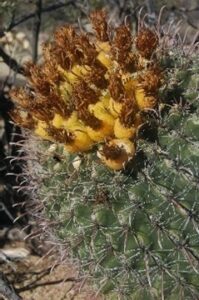
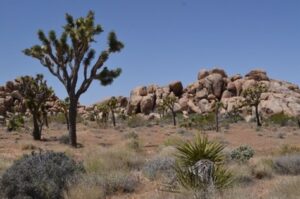

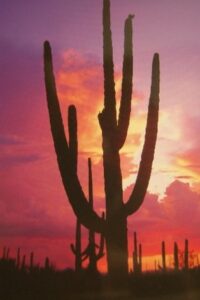
Deserts must be the Rodney Dangerfield of Earth’s landscapes. They just, “don’t get no respect.” If one searches for synonyms for the desert, words such as barren, desolate, wasteland, and desolation pop up. These are not the sorts of descriptions designed to make people excitedly rush to pack their things for a trip to a desert. My guess is that many a traveler glances out the car window and perceives a desert as a wasteland of monotonous, repetitive vistas, and little life. Far too easy it is to roar through the Sonoran or Mojave on I-10 and give this supremely arid land little due. Is it possible that seeing a desert in this way is an unfortunate misjudgment? Is it thinkable that, with a little practice and a degree of patience, deserts might be seen in an entirely different light? Perhaps so, consider these reflections.
First, a desert is what ecologists call a biome. Biomes are large geographic areas each characterized by a particular climate, flora, and fauna. Deciduous forest, taiga, tropical rainforest, prairie, tundra, and coral reef would be other examples of biomes. I hadn’t visited a desert in quite a spell. I’ll use that as a poor excuse for needing a reminder that this biome is incredibly biodiverse and beautiful.
Even though we think of deserts as a specific type of biome, not all deserts are alike. For example, they may not always be the scorchingly hot realms we often assume. Some have seasonal cold periods. I once saw Saguaro National Park near Tucson blanketed in snow. The largest desert area on earth is also one of the most frigid places on the planet. Antarctica gets only a couple of inches of precipitation each year. By this standard it is a desert.
Deserts are places that receive ten inches or less precipitation each year. Generally, they also have low humidity and high evaporation rates. Moisture that does fall doesn’t stick around for long. Much of it ends up residing in the bodies of the plants and animals living there.
 Globally the desert biome has its distinctive subdivisions. The Sonoran Desert of Arizona is the place to look for the saguaro cactus or the elf owl for example. To see Joshua trees or a desert tortoise one would venture into the Mojave. For a picturesque mixture of creosote bush, yucca, and ocotillo the Chihuahuan Desert of southwestern Texas is the place to be. The Great Basin Desert of Nevada offers vast stretches of sagebrush flats and the chance to catch a glimpse of a fleeing sagebrush vole.
Globally the desert biome has its distinctive subdivisions. The Sonoran Desert of Arizona is the place to look for the saguaro cactus or the elf owl for example. To see Joshua trees or a desert tortoise one would venture into the Mojave. For a picturesque mixture of creosote bush, yucca, and ocotillo the Chihuahuan Desert of southwestern Texas is the place to be. The Great Basin Desert of Nevada offers vast stretches of sagebrush flats and the chance to catch a glimpse of a fleeing sagebrush vole.
Likewise, the great sand dunes of the Sahara in Africa, the cold expanses of the Gobi in Asia, the ancient plains of the Namib lying on Africa’s Atlantic coast, and the fog swept ridges of the Chilean Atacama have their distinguishing plant and animal communities as well.
Joshua Tree National Park was the site of my most recent desert experience. Immersion in the Mojave Desert of southern California brought back memories of my first exposure to the desert biome and prompted me to recall why I find this rich, dry world so fascinating.
 The temperature in the spring season was not fearsomely high. The thermometer registered around 80F. In nearby Palm Springs, hundreds of feet lower in elevation, the daytime temperature was 95F. But summer would be a different story. In both places, the heat of the day can reach 120F. For humans, this makes hiking a questionable and potentially dangerous proposition. For the organisms that make this place their home, evolutionary adaptations for surviving such extremes of temperature and aridness are required.
The temperature in the spring season was not fearsomely high. The thermometer registered around 80F. In nearby Palm Springs, hundreds of feet lower in elevation, the daytime temperature was 95F. But summer would be a different story. In both places, the heat of the day can reach 120F. For humans, this makes hiking a questionable and potentially dangerous proposition. For the organisms that make this place their home, evolutionary adaptations for surviving such extremes of temperature and aridness are required.
Like many of our national parks, Joshua Tree is heavily visited. On average, over eight thousand people per day enter the park, although most come during the cooler October to May time frame. Still, this adds up to around three million visitors per year. Naturally this can make for trails bustling with hikers. So it was that I unexpectedly encountered one of the desert’s great gems – its immense silence. Finding some shade beneath a huge boulder, and off the beaten path, my wife and I sat surveying our surroundings as we munched on a snack and rehydrated.
Of a sudden, I realized that there were no other human voices, no shrieks from excited children. I heard no loud, intrusive, disconnected chitchat from tourists walking along in oblivious detachment from the beauty of their surroundings. Only the wind, gently rustling through the pinyon pines and scrub oak, impinged upon the utter quietness. A psithurism such a sound was once called. This from the Greek word psithuros meaning whisper.
How rare it is these days to find oneself in a place that does not suffer the invasive, synthetic sounds of human activity. How easily one can imagine the calming stillness which was a daily gift for our early ancestors. There was something powerful about that noiselessness. I felt a quietening tranquility, a sensation of smallness in a big, big world. This is the way it should be the wind seemed to murmur.
As we sat, reveling in the ability to be alone in this wondrous place, we became aware of other sounds. But these were also natural resonances and added to the sense that we were privy to a special time and place. From a nearby pinyon pine issued a sharp plink plink call. Movement within the pine revealed a Bewick’s wren foraging for insects. Suddenly a tiny black and white rocket whizzed overhead accompanied by a rattling, screeee call. A white-throated swift, one of the world’s fastest birds, was patrolling its feeding grounds. The distinct buzz of tiny, rapidly beating wings sounded as a black-chinned hummingbird zoomed in and had a brief rest on a nearby brittlebush. From somewhere in the trees nearby came the trilling call of a black-throated sparrow. By sitting patiently and listening, we found that there was bird life all around us.
There were other desert inhabitants here too. An eye-catching movement alerted us to the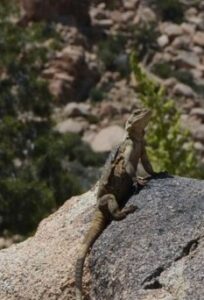 presence of a young chuckwalla lizard. Cautiously it climbed onto a prime basking spot atop an inviting granite boulder. Reptiles lack the physiological mechanisms mammals possess which automatically regulate their body temperatures. Ours for example hovers, without conscious effort, around the commonly expressed standard of 98.6F. Reptiles rely more on behavioral mechanisms and environmental factors to maintain their body temperature. Reptilian temperatures may fluctuate more than ours, but they can behaviorally keep their body temperature within a comparatively narrow, preferred range. The chuckwalla was using such behavioral mechanisms now. By basking in the sun and orienting its body for maximum exposure, the lizard was raising its body temperature to an optimum high. Having successfully warmed itself, the chuckwalla could more efficiently hunt for prey. Should the lizard become too hot, it would resort to shade-seeking behavior to reduce its temperature.
presence of a young chuckwalla lizard. Cautiously it climbed onto a prime basking spot atop an inviting granite boulder. Reptiles lack the physiological mechanisms mammals possess which automatically regulate their body temperatures. Ours for example hovers, without conscious effort, around the commonly expressed standard of 98.6F. Reptiles rely more on behavioral mechanisms and environmental factors to maintain their body temperature. Reptilian temperatures may fluctuate more than ours, but they can behaviorally keep their body temperature within a comparatively narrow, preferred range. The chuckwalla was using such behavioral mechanisms now. By basking in the sun and orienting its body for maximum exposure, the lizard was raising its body temperature to an optimum high. Having successfully warmed itself, the chuckwalla could more efficiently hunt for prey. Should the lizard become too hot, it would resort to shade-seeking behavior to reduce its temperature.
Chuckwallas also have an interesting defense mechanism. When exposed to danger from a predator, they seek refuge within cracks in the rocks of their habitat. Here they inflate themselves by gulping air. This body expansion, their sharp claws, and rough, scaly skin help to securely wedge them into the rock crevice. Such behavior might prove effective against a bobcat or roadrunner but not the Cahuilla or Mojave people who once thrived here. By puncturing the lizard’s body with a spear or sharpened stick, the animal could then be drawn out. Tribal people in Death Valley made a specialized, barbed tool for capturing them. The chuckwallas were then eaten, most commonly by roasting them over coals.
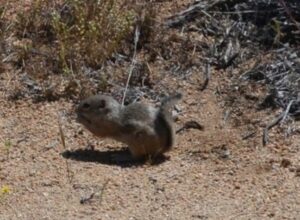 Another desert dweller soon made an appearance. From beneath a cluster of hedgehog cacti, a small chipmunk-like squirrel appeared. Busily searching the ground for fallen seeds, fruits, and insects was a white-tailed antelope squirrel. Upon finding an appealing morsel, the squirrel sat upon its hind legs and, in typical squirrel fashion, manipulated the food with its forepaws. The underside of its tail, a startlingly white color and perfect for reflecting the sun’s rays, was arched over its back to act as a sunshade.
Another desert dweller soon made an appearance. From beneath a cluster of hedgehog cacti, a small chipmunk-like squirrel appeared. Busily searching the ground for fallen seeds, fruits, and insects was a white-tailed antelope squirrel. Upon finding an appealing morsel, the squirrel sat upon its hind legs and, in typical squirrel fashion, manipulated the food with its forepaws. The underside of its tail, a startlingly white color and perfect for reflecting the sun’s rays, was arched over its back to act as a sunshade.
Foraging in the daytime like this can be risky. Overheating and respiratory water loss are possibilities for the rodent and can be life-threatening. Because of this, the diminutive squirrel will frequently retreat to a cooler, shady spot and press its belly to the ground. With limbs spread like a little skydiver, the squirrel can transfer body heat to the cooler soil. Most of the antelope squirrel’s water supply comes from the foods that it eats.
Sitting in the shade and scanning our surroundings, the richness of the desert became ever more apparent. Because we were sitting within the transition zone between desert scrub and the low montane forest, the plant life was especially diverse. Pinyon pines, whose nuts were once a staple in the diet of the Native Americans who lived here, and scrub oak were dominant. But a mere glancing about revealed beavertail and hedgehog cactus in bloom. Huge spikes of Mojave yucca flowers surged upward and were being heavily visited by bees searching for pollen or nectar. Mariposa lily, desert paintbrush, apricot mallow, and ocotillo flowers added to the mosaic of colors visible around us. It was akin to sitting in a garden painting by Monet, albeit one with a sense of propriety regarding flaunting one’s rich colors too extravagantly.
mere glancing about revealed beavertail and hedgehog cactus in bloom. Huge spikes of Mojave yucca flowers surged upward and were being heavily visited by bees searching for pollen or nectar. Mariposa lily, desert paintbrush, apricot mallow, and ocotillo flowers added to the mosaic of colors visible around us. It was akin to sitting in a garden painting by Monet, albeit one with a sense of propriety regarding flaunting one’s rich colors too extravagantly.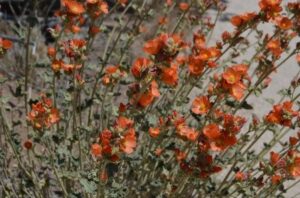
Visiting the Mojave was a marvelous experience and a timely reminder of how inherently fascinating a desert can be. It has been my good fortune to experience many of our planet’s biomes. Each, in its own way, displays the incredible power of the natural world to fill every available niche with living things of immense curiosity, intriguing lifestyles, and beauty. Organisms living in the desert are extraordinarily well-adapted for survival in their dry world.
Our American deserts are no less enthralling than other biomes. There is a recipe for reaping the rewards of the desert’s biological richness and beauty. It is this: start with a good portion of inquisitive mindset, add a dash of patient observation, stir in an appreciation for austerity, and blend all with an awareness of the fascinating array of biological adaptations needed to survive here. The completed dish will be deliciously pleasurable.
